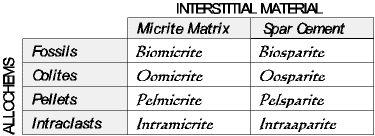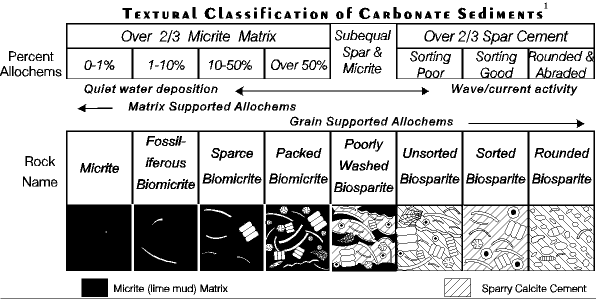
| Siliciclastic Rocks | Carbonate Rocks | |
| QUARTZ arenite | SHALE | LIMESTONE/DOLOMITE |
Limestones are not single composition rocks but a group of related rocks all composed of CaCO3 and reacting with dilute HCl acid. Limestone [CaCO3] is also chemically related to dolomite [CaMg(CO3)2]. Because all these rocks have CO3- - in common they are called the carbonates. The composition of most carbonates is derived from a combination of biological and chemical components.
Two carbonate classification systems are in common use today, one by R.L. Folk and the second by R.J. Dunham . The Dunham system is based on depositional texture (that is, the amount of matrix surrounding the grains at the time of deposition). It uses such names as mudstone, wackestone, packstone, grainstone, and boundstone. Each classification has its strengths, but we use the Folk system here.
Carbonate rock names (limestones and dolomites) consist of a conjunction of two names, one describing the ALLOCHEMS, the large pieces, the other describing the INTERSTITIAL MATERIAL. Allochems are equivalent to gravel, sand, lithics or feldspars in the siliciclastics. Interstitial material is equivalent to clay or cements in clastics. There are four kinds of allochems:
| ALLOCHEMS | Fossils - may be whole fossils, or broken and abraded fossils; all are called "bio" fragments |
| Oolites - small, pearl-like spheres | |
| Pellets - fecal pellets produced by invertebrate animals; look superficially like oolites but are dull and not pearl-like | |
| Intraclasts - chunks of eroded limestone deposited as a conglomerate |
Micrite and Sparite Interstitial Material
Micrite is "lime mud", the dense, dull-looking sediment made of clay sized crystals of CaCO3. Much micrite today forms from the breakdown of calcareous algae skeletons. It is not clear if all ancient micrites formed in the same way. Many carbonates are composed of nearly 100% micrite. Such rocks are simply called micrites.
With carbonates containing allochems the question is whether micrite is present or absent as an interstitial material, and if present by how much. If micrite is present during deposition then it fills the spaces between the allochems and the rock will be given a name which describes the allochems in a micrite matrix. For example, a rock with fossil fragments embedded in micrite is called a "biomicrite". Biomicrite is analogous to a siliciclastic wacke, sand imbedded in a lot of matrix.
If, on the other hand, the depositional environment has strong currents, only allochems may be deposited. If we could see the sediment during deposition all the allochems would be loose, like a pure sand or gravel. This is analogous to a 100% siliciclastic sand on a beach with no silt or clay. (With carbonates, though, such "clean" sands are not confined to beaches.) Micrite in these cases, being clay sized, has been washed away. The rock formed is then composed only of allochems, held together by clear to translucent calcite crystals with rhombohedral cleavage (called SPAR or SPARITE) acting as a cement. The spar is precipitated from fresh or marine water percolating through the sediment after deposition, but before final cementation. This oosparite shows well the spar cement.
Classification of Carbonates
The classification of carbonates using the allochem/interstitial material system (the Folk System) is very systematic and straight forward. The allochem name is combined with the interstitial name (micrite or spar). The table below shows the major categories of carbonate rocks based on their allochems and interstitial material.

But what happens if there is more than one allochem in the rock, or there is a mixture of micrite and spar? This classification system has great flexibility and creativity. You can easily build your own descriptive rock names. The name is built up by stringing together all the allochem names in order from least to most abundant, and then adding the interstitial material name ("matrix" below for short). For example, a rock like this:
Oolites + Fossils + Spar matrix = Oo bio sparite
The name is written as one word, Oobiosparite.
Another example (again allochems from least to most abundant):
Pellets + Oolites + Fossils + Micrite matrix = pel oo bio micrite
The name is written as one word, Peloobiomicrite.
But what if there is both micrite and spar matrix? The system is the same; just list them from least to most abundant.
Fossils + Spar matrix + Micrite matrix = bio spar micrite
This system goves through other levels of refinement, such as the table below where the abundance of allochems is dealt with. Other modifiers deal with different sizes of allochems. But all this is beyond our discussion here.

A classification such as this one works well if you want to construct rock names from observations. The system, however, does not lend itself well to constructing keys for classification. A key requires the establishment of arbitrary categories of rocks, and a system like the one above deal with all the myriad combinations that are possible.
Nonetheless, we have constructed a key to identify rocks based on their allochems and interstitial material. Just be aware that its main weakness is that there are always rocks that do not fit easily into its simple categories.